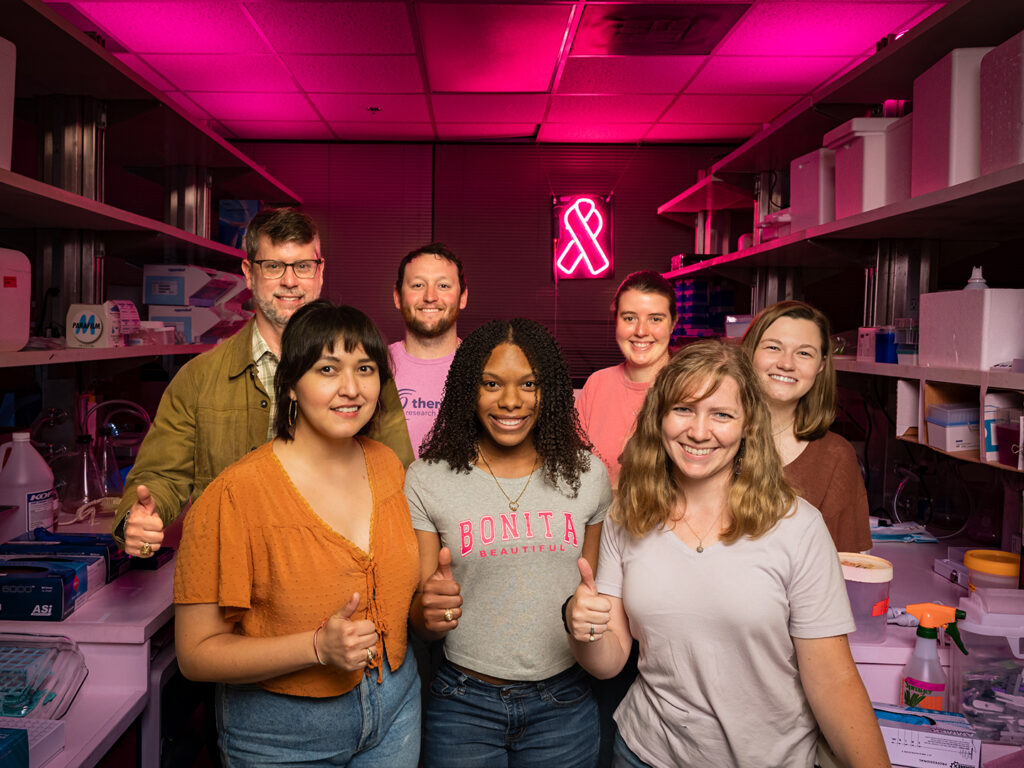Patient Advocates Help Researchers Forge New Paths In Breast Cancer Research
Story by Courtney Price, VMBS Communications

Photo by Jason Nitsch ’14, Texas A&M University Division of Marketing and Communications
A chance meeting between breast cancer researchers from the Texas A&M School of Veterinary Medicine & Biomedical Sciences (VMBS) and patient advocates at the Metastatic Breast Cancer Research Conference (MBCRC) has sparked a new passion for making patient advocates an integral part of breast cancer research.
Dr. Garhett Wyatt, a postdoctoral researcher at the VMBS, has been researching breast cancer since 2016 and attending the MBCRC since 2017 with Dr. Weston Porter, a professor in the Department of Veterinary Physiology & Pharmacology and Wyatt’s lab supervisor.
For Wyatt, studying breast cancer is a tribute to his grandmother, who died of metastatic breast cancer in 2009.
“She had a radical mastectomy when the cancer first appeared, and I was too young to remember any of that,” Wyatt said. “But 15 years later, the cancer came back, and three years after that, it was metastatic. I vividly remember the pain she went through. It’s part of why I chose to study breast cancer.”
Given his family history, Wyatt is passionate about furthering breast cancer research, and it’s one reason that he keeps attending MBCRC.
At the 2021 conference, he joined a breakout session focused on including patient advocates in the research process. Doing so led Wyatt to consider his research in a new light.
Gaining A New Perspective
Up until 2021, the MBCRC was mostly directed at patient advocates and clinicians who could put conference attendance toward their continuing education certification requirements.
Realizing that there were several conferences filling the same role, the MBCRC shifted focus in 2021 toward connecting patient advocates and researchers, including hosting a new type of breakout session designed to get the two groups talking about how to communicate with each other.
“The researchers went into one room to have a discussion and the advocates went into another,” Wyatt said. “But a couple researchers and advocates snuck into each other’s rooms, and that sort of helped us realize that we don’t need to be separating each other.
“There were also a few informal events where we could talk to patient advocates about our science but practice communicating it in accessible terms,” he said. “Being able to explain to the advocates what certain tests do and how they relate to real life was very important.”
The next year, an organization called Guiding Researchers and Advocates to Scientific Partnerships (GRASP) joined the MBCRC as the official advocacy program. It organized more breakout sessions and a special poster session to help connect patient advocates and researchers even further.
At the poster session, Wyatt learned that sharing knowledge wasn’t just about making cancer science accessible to patient advocates — the advocates had important lessons to teach, too.
“While I was speaking with advocates about my research poster, I came to realize that talking about metastatic cancer can be a very sensitive subject, especially for people with a diagnosis,” he said. “By talking with advocates, I learned better ways to communicate about the science of breast cancer with compassion for whoever might be listening.”
Metastatic breast cancer, also called Stage 4, is diagnosed when breast cancer has spread to other parts of the body, most commonly the bones, lungs, liver and brain.
More than 40,000 people in the United States die each year because of metastatic breast cancer, and there is no cure, according to Theresa’s Research Foundation (TRF), which hosts the annual MBCRC. Receiving a diagnosis can be emotionally devastating.

Photo by Jason Nitsch ’14, Texas A&M University Division of Marketing and Communications
Through these experiences, Wyatt learned that patient advocates can be a valuable source of information about the realities of living with metastatic breast cancer.
“At the 2022 conference, I was able to meet Christine Hodgdon and Julia Maués, the founders of GRASP, and I started sharing about my research with Piqray, which is a drug therapy for certain kinds of advanced breast cancer,” he said.
“Christine and Julia made me aware of just how awful the side effects of Piqray can be for patients. For them, it almost doesn’t matter that the drug works, because the side effects are so bad,” he said. “It’s one thing to read about side effects in clinical trial reports, but it’s another to hear about people’s real experiences living with them.”
While researchers are passionate about helping people, their work often takes place far away from patients with the conditions they study and hearing this kind of feedback has become critical for guiding Texas A&M scientists in conducting research that addresses both the short-term and long-term needs of breast cancer patients.
“When I’m working with cells on a plastic plate in a cell culture hood, it’s easy to get tunnel vision,” Wyatt said. “That’s what makes the chance to talk to patient advocates so valuable.”
In 2023, MBCRC launched a new program with the help of GRASP called the MBCRC Advocate Researcher Program (MARP) that paired researchers with patient advocates to share their perspectives and write blogs about the experience.
Wyatt, who now envisions patient advocates being a permanent part of his research process, was a member of the program’s first cohort and was paired with Stephanie Walker, who, in her own words, is a “breast cancer thriver.”
“I look forward to staying in touch with Stephanie to share what we are doing here at Texas A&M and to stay up to date on her treatments,” Wyatt said.
Wyatt was joined by Hannah Carter, a graduate student from Porter’s lab.
“Our collaboration wasn’t just about exchanging information; it was about sharing a common mission — to combat metastatic breast cancer,” Carter wrote in her blog with advocate partner Katie Edick.
“Katie’s decision to share her personal journey and become the face of breast cancer added an essential human dimension to our collaboration. It reinforced the urgency and importance of our work.”
Working Together
For many scientists, working with patient advocates to beat breast cancer can be extremely personal.
“Two years ago, my mother passed away from metastatic breast cancer,” said Porter, who has been studying breast cancer for over two decades. “I actually saw some of the side effects of the drugs we were studying in the lab firsthand. It’s made me even more passionate about this topic.”
It’s also personal for Josh Newby, executive director of TRF.

Photo by Jason Nitsch ’14, Texas A&M University Division of Marketing and Communications
“My mother, Theresa, who co-founded the organization with me, believed that we needed to work together with everyone in order to make a difference,” Newby said. “We started the conference after she passed away, but we wanted to continue pursuing that vision she had outlined. After a few years, we realized that we needed to include patient advocates in the conference to understand what kind of research was needed.”
Having scientists collaborate with patient advocates is a mutually beneficial arrangement that is already shaping breast cancer research.
“It really started about 30 years ago, when the Department of Defense started the Congressionally Directed Medical Research Programs,” Porter said. “As part of their program for breast cancer research, they began putting patient advocates on the grant review panel in order to help break through communication silos.”
“The most exciting thing to come from bringing in patient advocates has been the connections between advocates and trainees and early-career researchers,” Newby said. “We have found that making these connections early in someone’s training can have a lasting impact.”
There’s also a huge potential for other communities to embrace the same research model.
“It doesn’t matter whether you work with breast cancer or not,” Wyatt said. “Finding someone who has been diagnosed with the condition you study and hearing their story can really change how you go about pursuing research.”
One reason that partnerships between advocates and researchers work is because of the strength of the patients.
“There’s a different drive among these women,” Porter said. “They’re passionate about sharing their experiences and being part of the research. They’re absolutely amazing to talk with.”
Thanks to the work of TRF, many more researchers are beginning to seek out ways to involve patient advocates earlier in the research process. Doing so may lead to new strategies like combining lower amounts of existing drugs or using smaller doses as part of an overall management strategy that will give equal consideration to both patient quality of life and elimination of the cancer.
“What we’re seeing now goes beyond what the Department of Defense was doing before — now, it’s researchers actively looking for ways to partner with patients,” Porter said. “It’s changing the way researchers think.”
###
For more information about the Texas A&M School of Veterinary Medicine & Biomedical Sciences, please visit our website at vetmed.tamu.edu or join us on Facebook, Instagram, and Twitter.
Contact Information: Jennifer Gauntt, Director of VMBS Communications, Texas A&M School of Veterinary Medicine & Biomedical Sciences, jgauntt@cvm.tamu.edu, 979-862-4216


